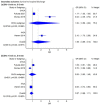How Epinephrine Administration Interval Impacts the Outcomes of Resuscitation during Adult Cardiac Arrest: A Systematic Review and Meta-Analysis
- PMID: 36675411
- PMCID: PMC9860904
- DOI: 10.3390/jcm12020481
How Epinephrine Administration Interval Impacts the Outcomes of Resuscitation during Adult Cardiac Arrest: A Systematic Review and Meta-Analysis
Abstract
Current guidelines for treating cardiac arrest recommend administering 1 mg of epinephrine every 3−5 min. However, this interval is based solely on expert opinion. We aimed to investigate the impact of the epinephrine administration interval (EAI) on resuscitation outcomes in adults with cardiac arrest. We systematically reviewed the PubMed, EMBASE, and Scopus databases. We included studies comparing different EAIs in adult cardiac arrest patients with reported neurological outcomes. Pooled estimates were calculated using the IVhet meta-analysis, and the heterogeneities were assessed using Q and I2 statistics. We evaluated the study risk of bias and overall quality using validated bias assessment tools. Three studies were included. All were classified as “good quality” studies. Only two reported the primary outcome. Compared with a recommended EAI of 3−5 min, a favorable neurological outcome was not significantly different in patients with the other frequencies: for <3 min, odds ratio (OR) 1.93 (95% CI: 0.82−4.54); for >5 min, OR 1.01 (95% CI: 0.55−1.87). For survival to hospital discharge, administering epinephrine for less than 3 min was not associated with a good outcome (OR 1.66, 95% CI: 0.89−3.10). Moreover, EAI of >5 min did not pose a benefit (OR 0.87, 95% CI: 0.68−1.11). Our review showed that EAI during CPR was not associated with better hospital outcomes. Further clinical trials are necessary to determine the optimal dosing interval for epinephrine in adults with cardiac arrest.
Keywords: cardiac arrest; cardiopulmonary resuscitation; epinephrine; interval.
Conflict of interest statement
The authors declare no conflict of interest.
Figures



Similar articles
-
Epinephrine dosing interval and neurological outcome in out-of-hospital cardiac arrest.Perfusion. 2022 Nov;37(8):835-846. doi: 10.1177/02676591211025163. Epub 2021 Jun 12. Perfusion. 2022. PMID: 34120526
-
Intraosseous versus intravenous vascular access during cardiopulmonary resuscitation for out-of-hospital cardiac arrest: a systematic review and meta-analysis of observational studies.Scand J Trauma Resusc Emerg Med. 2021 Mar 8;29(1):44. doi: 10.1186/s13049-021-00858-6. Scand J Trauma Resusc Emerg Med. 2021. PMID: 33685486 Free PMC article.
-
Epinephrine dosing interval and survival outcomes during pediatric in-hospital cardiac arrest.Resuscitation. 2017 Aug;117:18-23. doi: 10.1016/j.resuscitation.2017.05.023. Epub 2017 May 25. Resuscitation. 2017. PMID: 28552658
-
Community first responders for out-of-hospital cardiac arrest in adults and children.Cochrane Database Syst Rev. 2019 Jul 19;7(7):CD012764. doi: 10.1002/14651858.CD012764.pub2. Cochrane Database Syst Rev. 2019. PMID: 31323120 Free PMC article.
-
Standard dose epinephrine versus placebo in out of hospital cardiac arrest: A systematic review and meta-analysis.Am J Emerg Med. 2019 Mar;37(3):511-517. doi: 10.1016/j.ajem.2018.12.055. Epub 2019 Jan 11. Am J Emerg Med. 2019. PMID: 30658877
Cited by
-
Assessing Key Factors Influencing Successful Resuscitation Outcomes in Out-of-Hospital Cardiac Arrest (OHCA).J Clin Med. 2024 Dec 4;13(23):7399. doi: 10.3390/jcm13237399. J Clin Med. 2024. PMID: 39685857 Free PMC article.
References
-
- Virani S.S., Alonso A., Aparicio H.J., Benjamin E.J., Bittencourt M.S., Callaway C.W., Carson A.P., Chamberlain A.M., Cheng S., Delling F.N., et al. Heart Disease and Stroke Statistics—2021 Update: A Report From the American Heart Association. Circulation. 2021;143:E254–E743. doi: 10.1161/CIR.0000000000000950. - DOI - PubMed
-
- Yan S., Gan Y., Jiang N., Wang R., Chen Y., Luo Z., Zong Q., Chen S., Lv C. The Global Survival Rate among Adult Out-of-Hospital Cardiac Arrest Patients Who Received Cardiopulmonary Resuscitation: A Systematic Review and Meta-Analysis. Crit. Care. 2020;24:61. doi: 10.1186/s13054-020-2773-2. - DOI - PMC - PubMed
-
- Wongtanasarasin W., Ungrungseesopon N., Namsongwong N., Chotipongkul P., Visavakul O., Banping N., Kampeera W., Phinyo P. Association between Calcium Administration and Outcomes during Adult Cardiopulmonary Resuscitation at the Emergency Department. Turk. J. Emerg. Med. 2022;22:67. doi: 10.4103/2452-2473.342805. - DOI - PMC - PubMed
-
- Kienzle M.F., Morgan R.W., Faerber J.A., Graham K., Katcoff H., Landis W.P., Topjian A.A., Kilbaugh T.J., Nadkarni V.M., Berg R.A., et al. The Effect of Epinephrine Dosing Intervals on Outcomes from Pediatric In-Hospital Cardiac Arrest. Am. J. Respir. Crit. Care Med. 2021;204:977–985. doi: 10.1164/rccm.202012-4437OC. - DOI - PMC - PubMed
-
- Perkins G.D., Kenna C., Ji C., Deakin C.D., Nolan J.P., Quinn T., Fothergill R., Gunson I., Pocock H., Rees N., et al. The Effects of Adrenaline in out of Hospital Cardiac Arrest with Shockable and Non-Shockable Rhythms: Findings from the PACA and PARAMEDIC-2 Randomised Controlled Trials. Resuscitation. 2019;140:55–63. doi: 10.1016/j.resuscitation.2019.05.007. - DOI - PubMed

